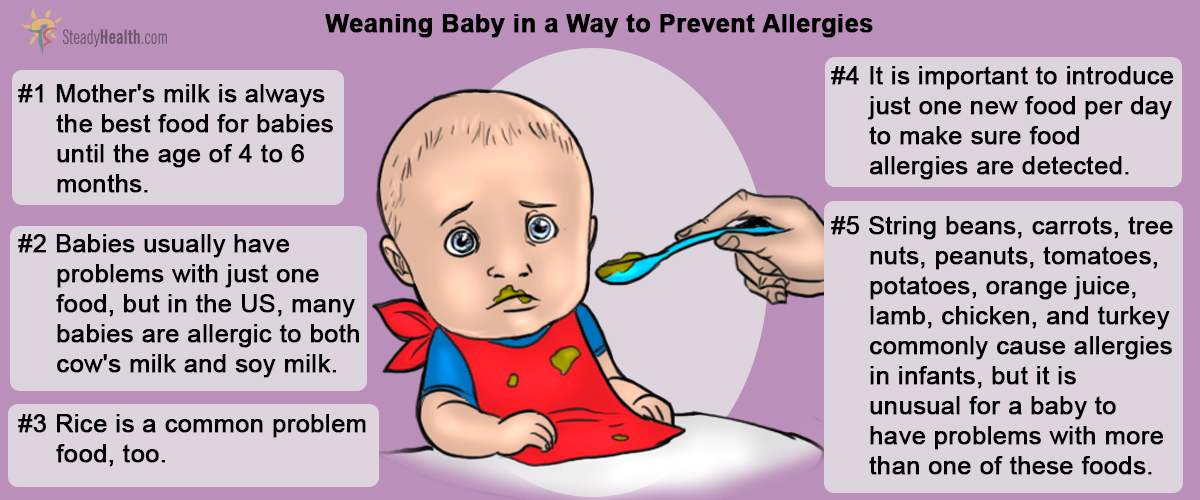Most of us know of--or are parents to--an infant or a young child who just can't tolerate certain kinds of foods. The itching, rashes, diarrhea, and gas caused by offending foods aren't allergies in the sense they trigger the rapid reactions in the immune system that occur in, for instance, hay fever, but they are slower and more systemic reactions to certain proteins in foods.
In the USA, children and infants who are already on solid food tend to have problems with peanuts, tree nuts (especially almonds, walnuts, and pecans), wheat, soy, milk, eggs, fish, and shellfish. In the EU, children most commonly react to mustard, celery, sesame seeds, lupine flour, mollusks, soy, peanuts, eggs, fish, and shellfish. In Asia, allergies to peanuts are almost unknown, but some experts refer to an epidemic of allergies to shellfish and to some kinds of milk sugars that occur in formula but not in regular cow's, sheep's, goat's, yak's, or camel's milk. Some foods that people in the West would consider "exotic," such as bird's nest and sea squirts, even in minute amounts, cause serious problems for children in Asia.
When kids get food allergies, their parents naturally put them on hypoallergenic substitutes. Rice is especially popular, as are fruit, meat, and vegetables. In Europe, Australia and New Zealand, and the USA, parents who see that their children don't do well on cow's milk often offer them a substitute, such as goat's milk. Researchers tell us that the problem with substituting foods, however, is that the list of problem foods is longer than most of us have been told.
- Cow's milk is a common problem food in the US, in the EU, and in Australia and New Zealand. Goat's milk, surprisingly, is a problem food in the Middle East, Latin America, and Asia, where it is more commonly consumed than cow's milk.
- Severe allergies to peanuts are not rare in the US. They are almost unknown in Africa and Asia.
- Reactions to beef are relatively common in beef-eating countries, such as Argentina and the US. Reactions to lamb are relatively common in Australia, New Zealand, and the Middle East.
- Children in Asia, Africa, and Latin America tend to have more skin reactions than gastrointestinal reactions to foods. Children in Australia, New Zealand, the EU, the UK, and the United States tend to get both the diarrhea, bloating, and gas and the rashes and itching that can be caused by "slow" immune system reactions to food proteins.
See Also: When to start infant cereal and baby food?
Potential problem foods also include peas, lentils, squash, yam, jicama, orange juice, tomatoes, potatoes, carrots, green (string) beans, barley, lentils, chicken, and lemon. Sometimes it is necessary to eliminate all of these foods to get the problem of food-protein induced enterocolitis syndrome under control. But if you eliminate a long list of foods, how do you make sure your child gets enough nutrients?
Making Sure Your Child Gets Enough Nutrients Despite Food Allergies
When a child has just one food allergy, it is not especially hard to make sure that the diet is adequately nutritious. In studies of children in Australia, 83% of those diagnosed with food-protein induced enterocolitis syndrome are sensitive to just one food. At least two studies conducted in Australia found that no child was sensitive to both cow's milk and soy.

International studies have found that rice is often a problem food when there is sensitivity to soy, cow's milk, sweet potato, or banana. Rice is the problem food most often overlooked in children's diets all over the world.
So what can parents do?
- Breastfeed as long as possible. Children typically do not develop an allergy to mother's milk, even when their mothers consume foods that are problematic for the child.
- Consult a pediatrician about choice of formula. Sometimes "extensively hydrolyzed" cow's milk formulas are suitable for infant nutrition. These formulas have the allergenic proteins in the milk broken down into forms that do not trigger a reaction by the baby's immune system.
- Some children grow faster when they are given amino acid formulas.
- When children need to catch up in their development because they had digestive problems as infants, it may be a good idea to put formula in sippy cups, use formula in baked goods, or to add a few drops of vanilla to the formula to make it more palatable. A dietitian or nutrition should be able to give you guidance on exactly how much formula you should give your child.
Sometimes children can't tolerate certain foods in one form but can tolerate them in another.
Typically, baking or frying (not that we suggest you feed your child lots of fried foods) breaks down allergy-causing proteins so that allergy isn't the problem with the food. However, the standard of care for food-induced enterocolitis usually is complete avoidance of offending foods, so consult your physician before giving your child even small amounts of problem items.
Sometimes babies don't show any signs of food allergies until they are weaned, about the age of six months. To be on the safe side, it is usually a good idea to start with:
- Corn cereal, instead of rice or wheat cereal, followed by barley, millet, and then, cautiously, rice.
- Broccoli, parsnip, and pumpkin first, then try sweet potato, tomatoes, potatoes, carrots, and string beans, one at a time, watching for reactions.
- Meat before fish, beef before lamb or chicken.
- Beans before peas and lentils.
- Any fruit except banana and oranges at first.
See Also: Food Allergies in Children - Causes and Allergens, Symptoms and Prevention
When baby is a fussy eater, take note. Your child may know when a food is a problem. Just introduce one new food at a time so you will have, we all hope, no more than one allergic reaction.
- European Union. Directive 2007/68/EC of the European Parliament amendment of Directive 2000/13/EC. Official JEur Union 2007. L310:11.
- Katz Y, Goldberg MR. Natural history of food protein-induced enterocolitis syndrome. Curr Opin Allergy Clin Immunol 2014. 14:229–239.
- U.S. Food and Drug Administration. Food allergens guidance. http://www.fda.gov/Food/GuidanceRegulation/GuidanceDocumentsRegulatoryInformation/Allergens/default.htm.2013. Accessed 8 June 2014.
- Mindmap by steadyhealth.com
- Photo courtesy of Andrew Malone by Flickr : www.flickr.com/photos/andrewmalone/3146863327



Your thoughts on this